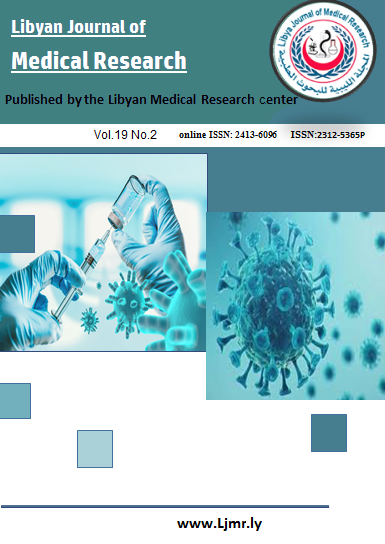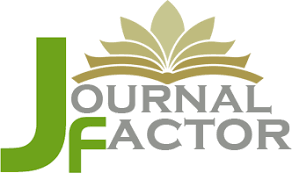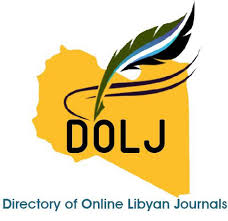Prevalence and Factors Influencing the Use of Herbal Medicines During Pregnancy in Libya: A Cross-Sectional Study
DOI:
https://doi.org/10.54361/LJMR.19.2.18Keywords:
Herbal Medicine, Libya, Pregnancy, Knowledge, Attitude, PracticeAbstract
Background:: Herbal medicines (HM) are commonly used during pregnancy worldwide, but safety concerns exist due to limited regulation and evidence. This study assesses the prevalence, knowledge, attitudes, and practices of HM use among pregnant women in Libya. Materials and Methods: A cross-sectional survey was conducted between March and June 2025, sampling 500 women across various regions in Libya. Participants completed a questionnaire evaluating their demographic characteristics, HM usage, and perceptions of safety and efficacy during pregnancy. Results: The results revealed that 50.8% of participants had used HM during pregnancy, with the third trimester being the most common period for use (44.6%). Cultural beliefs, perceived safety, and accessibility were key factors influencing the use of HM, with 77.8% relying on family or friends for advice. Alarmingly, 68.4% of women did not consult healthcare providers about their use of HM. Despite a general awareness of the side effects (88.6%), there was considerable uncertainty about the relative safety of HM compared to conventional medicine, with 26.2% of respondents unsure. The study showed that education level significantly influenced practices, with higher levels of education associated with less frequent use of HM during pregnancy (p <0.05). The number of children, previous pregnancies, and history of abortion have a significant effect on the increased use of HM (p <0.05). Conclusion: The study emphasizes the importance of improving patient education and provider engagement in the use of HM during pregnancy to reduce risks and promote safety. It also calls for regulatory frameworks to monitor HM use and prevent adverse outcomes, especially in vulnerable groups like pregnant women.
Downloads
References
1. Ekor M. The growing use of herbal medicines: Issues relating to adverse reactions and challenges in monitoring safety. Front Neurol. 2014;4 JAN. doi:10.3389/fphar.2013.00177
2. Mohammed A, Amsalu B, Hailu M, et al. Indigenous herbal medicine use and its associated factors among pregnant women attending antenatal care at public health facilities in Dire Dawa, Ethiopia: a cross-sectional study. BMJ Open. 2024;14(6). doi:10.1136/bmjopen-2023-079719
3. Moreira D de L, Teixeira SS, Monteiro MHD, De-Oliveira ACAX, Paumgartten FJR. Traditional use and safety of herbal medicines. Revista Brasileira de Farmacognosia. 2014;24(2):248-257. doi:10.1016/j.bjp.2014.03.006
4. WHO Traditional Medicine Strategy. 2014-2023. World Health Organization; 2013. Accessed February 4, 2025. https://www.who.int/publications/i/item/9789241506096
5. Wu CH, Wang CC, Tsai MT, Huang WT, Kennedy J. Trend and pattern of herb and supplement use in the United States: Results from the 2002, 2007, and 2012 national health interview surveys. Evidence-based Complementary and Alternative Medicine. 2014;2014. doi:10.1155/2014/872320
6. Bent S. Herbal medicine in the United States: Review of efficacy, safety, and regulation - Grand Rounds at University of California, San Francisco Medical Center. J Gen Intern Med. 2008;23(6):854-859. doi:10.1007/s11606-008-0632-y
7. Rashrash M, Schommer JC, Brown LM. Prevalence and Predictors of Herbal Medicine Use Among Adults in the United States. J Patient Exp. 2017;4(3):108-113. doi:10.1177/2374373517706612
8. von Conrady DM, Bonney A. 7. Patterns of complementary and alternative medicine use and health literacy in general practice patients in urban and regional Australia. Aust Fam Physician. 2017;46(5):315-320.
9. Bent S. 3. Herbal medicine in the United States: Review of efficacy, safety, and regulation - Grand Rounds at University of California, San Francisco Medical Center. J Gen Intern Med. 2008;23(6):854-859. doi:10.1007/s11606-008-0632-y
10. Rasmussen SA. 16. Human teratogens update 2011: Can we ensure safety during pregnancy? Birth Defects Res A Clin Mol Teratol. 2012;94(3):123-128. doi:10.1002/bdra.22887
11. Mbarambara PM, Songa PB, Wansubi LM, Mututa PM, Minga BBK. 17. Self-mediccation among pregnant women. 2016;16(1):38-45.
12. Kennedy DA, Lupattelli A, Koren G, Nordeng H. 18. Herbal medicine use in pregnancy: Results of a multinational study. BMC Complement Altern Med. 2013;13. doi:10.1186/1472-6882-13-355
13. Mohamed M, El-Kashif L, Ebrahim El-Tahry S. 15. An Assessment of the Factors Influencing the Use of over-the-Counter Medication during the Second Trimester of Pregnancy, Egypt. International Journal of Nursing Science. 2018;8(6):99-107. doi: 10.5923/j.nursing.20180806.01
14. Mauliddiyah NL. 11. Medicinal Plants and Pharmaceutical Medicines Use in Pregnant and Lactating Women in Ethiopia.; 2021.
15. Malan DF, Neuba DF. 19. Medicinal Plants and Pregnancy African Journal of Reproductive Health. 2011;15(1):85.
16. Shewamene Z, Dune T, Smith CA. The use of traditional medicine in maternity care among African women in Africa and the diaspora: A systematic review. BMC Complement Altern Med. 2017;17(1). doi:10.1186/s12906-017-1886-x
17. John LJ, Shantakumari N. 22. Herbal medicines use during pregnancy: A review from the middle east. Oman Med J. 2015;30(4):229-236. doi:10.5001/omj.2015.48
18. E E. 26. Herbal medicinal products during pregnancy: are they safe? BJOG. 2002;109(3):227-235.
19. Barnes LAJ, Barclay L, McCaffery K, Aslani P. 27. Complementary medicine products used in pregnancy and lactation and an examination of the information sources accessed pertaining to maternal health literacy: A systematic review of qualitative studies. BMC Complement Altern Med. 2018;18(1):1-27. doi:10.1186/s12906-018-2283-9
20. Muñoz Balbontín Y, Stewart D, Shetty A, Fitton CA, McLay JS. 29. Herbal medicinal product use during pregnancy and the postnatal period: A systematic review. Obstetrics and Gynecology. 2019;133(5):920-932. doi:10.1097/AOG.0000000000003217
21. Nyeko R, Tumwesigye NM, Halage AA. 30. Prevalence and factors associated with use of herbal medicines during pregnancy among women attending postnatal clinics in Gulu district, Northern Uganda. BMC Pregnancy Childbirth. 2016;16(1):1-12. doi:10.1186/s12884-016-1095-5
22. Alemdaroglu, N.C.; Dietz, U.; Wolffram, S.; Spahn-Langguth, H.; Langguth P. 31. Influence of green and black tea on folic acid pharmacokinetics in healthy volunteers: potential risk of diminished folic acid bioavailability. Biopharm Drug Dispos. 2008;29(6):335-348.
23. Wilkinson JM. 33. What do we know about herbal morning sickness treatments? A literature survey. : Midwifery. 16(3):224-228.
24. Marty AT. 34. PDR for Herbal Medicines. Vol 281.; 1999. doi:10.1001/jama.281.19.1853
25. Orief YI, Farghaly NF, Ibrahim MIA. 35. Use of herbal medicines among pregnant women attending family health centers in Alexandria. Middle East Fertil Soc J. 2014;19(1):42-50. doi: 10.1016/j.mefs.2012.02.007
26. Ekor M. 38. The growing use of herbal medicines: Issues relating to adverse reactions and challenges in monitoring safety. Front Neurol. 2014;4 JAN(January):1-10. doi:10.3389/fphar.2013.00177
27. Agiel N, Mericli F. 43. A survey on the aromatic plants of Libya. Indian Journal of Pharmaceutical Education and Research. 2017;51(3): S304-S308. doi:10.5530/ijper.51.3s.35
28. Feng Y, Lei JQ, Xu XW, Pan BR. 44. Composition and characteristics of Libyan flora. Arch Biol Sci. 2013;65(2):651-658. doi:10.2298/ABS1302651Y
29. Louhaichi M, Salkini AK, Estita HE, Belkhir S. 48. Initial assessment of medicinal plants across the Libyan mediterranean coast. Adv Environ Biol. 2011;5(2 SPEC. ISSUE):359-370.
30. Arjaibi HM, Sherlala RA, Alameer EM, Hussain AA. Herbal Medicine Use and Attitudes during the COVID-19 Crisis in Libya: Cross-Sectional Study. University of Zawia Journal of Medical Sciences. 2025;1(1):16-23. doi:10.26629/uzjms.2025.03
31. Ashur ST, Shah SA, Bosseri S, Shamsuddin K. 49. Use of traditional medicine among type 2 diabetic Libyans. Eastern Mediterranean Health Journal. 2017;23(5):375-382. doi:10.26719/2017.23.5.375
32. Arjaibi HM, Sherlala RA, Mansour MH, Osman SA. Community Pharmacists’ Knowledge, Attitudes, and Practices Regarding Herbal Medicine: A Cross-Sectional Study in Libya. Medical and Pharmaceutical Journal. 2024;3(4):172-187. doi:10.55940/medphar2024108
33. Worldometer. 57. Libya Demographics. Worldometer. 2020. Accessed May 12, 2024. https://www.worldometers.info/demographics/libya-demographics/
34. Worldometer. Libya Population- Country Meter. Worldometer. 2024. https://countrymeters.info/en/Libya
35. Almoayad F, Assiri IA, Almarshoud HF, Safhi AM, Altahan HM, Benajiba N. 1. Exploring the use of herbal treatments during pregnancy among Saudi women an application of the knowledge-attitude-practice model. Sultan Qaboos Univ Med J. 2021;21(4):591-597. doi:10.18295/squmj.4.2021.045
36. M. Mothupi. 24. Use of herbal medicine during pregnancy among women with access to public healthcare in Nairobi, Kenya: A cross-sectional survey. BMC Complement Altern Med. 2014;14(1):1-8. http://www.embase.com/search/results?subaction=viewrecord&from=export&id=L601312998%0Ahttp://dx.doi.org/10.1186/1472-6882-14-432
37. Forster DA, Denning A, Wills G, Bolger M, McCarthy E. 25. Herbal medicine use during pregnancy in a group of Australian women. BMC Pregnancy Childbirth. 2006;6. doi:10.1186/1471-2393-6-21
38. Fakeye TO, Adisa R, Musa IE. 50. Attitude and use of herbal medicines among pregnant women in Nigeria. BMC Complement Altern Med. 2009; 9:1-7. doi:10.1186/1472-6882-9-53
39. Belayneh YM, Yoseph T, Ahmed S. 56. A cross-sectional study of herbal medicine use and contributing factors among pregnant women on antenatal care follow-up at Dessie Referral Hospital, Northeast Ethiopia. BMC Complement Med Ther. 2022;22(1):1-8. doi:10.1186/s12906-022-03628-8
40. Calapai G. 60. European legislation on herbal medicines: A look into the future. Drug Saf. 2008;31(5):428-431. doi:10.2165/00002018-200831050-00009
41. Briggs DR. 61. The regulation of herbal medicines in Australia. Toxicology. 2002;181-2:565-570. doi:10.1016/s0300-483x (02)00483-3
42. Leung C, Marvin V, Ofili-Yebovi D. 63. Herbal medicines in pregnancy. Pharmaceutical Journal. 2022;309(7966):1-17. doi:10.1211/PJ.2022.1.157273
43. Frawley J, Adams J, Sibbritt D, Steel A, Broom A, Gallois C et al. 64. Prevalence and determinants of complementary and alternative medicine use during pregnancy: results from a multinational study. BMC Complement Altern Med. 2013; 13:335. doi: https://doi.org/10.1186/1472-6882-13-355
44. Al-Ghamdi S, Aldossari K, Al-Zahrani J, et al. 23. Prevalence, knowledge and attitudes toward herbal medication use by Saudi women in the central region during pregnancy, during labor and after delivery. BMC Complement Altern Med.
Downloads
Published
Issue
Section
License
Copyright (c) 2025 Hajer M. Arjaibi , Hussam Alwafi , Najat Benyusef , Olfat N. Alqatish, Aisha M. Albhlool (Author)

This work is licensed under a Creative Commons Attribution-NonCommercial-NoDerivatives 4.0 International License.
Open Access Policy
Libyan journal of medical Research (LJMR).is an open journal, therefore there are no fees required for downloading any publication from the journal website by authors, readers, and institution.
The journal applies the license of CC BY (a Creative Commons Attribution 4.0 International license). This license allows authors to keep ownership f the copyright of their papers. But this license permits any user to download , print out, extract, reuse, archive, and distribute the article, so long as appropriate credit is given to the authors and the source of the work.
The license ensures that the article will be available as widely as possible and that the article can be included in any scientific archive.
Editorial Policy
The publication of an article in a peer reviewed journal is an essential model for Libyan journal of medical Research (LJMR). It is necessary to agree upon standards of expected ethical behavior for all parties involved in the act of publishing: the author, the journal editorial, the peer reviewer and the publisher.
Any manuscript or substantial parts of it, submitted to the journal must not be under consideration by any other journal. In general, the manuscript should not have already been published in any journal or other citable form, although it may have been deposited on a preprint server. Authors are required to ensure that no material submitted as part of a manuscript infringes existing copyrights, or the rights of a third party.
Authorship Policy
The manuscript authorship should be limited to those who have made a significant contribution and intellectual input to the research submitted to the journal, including design, performance, interpretation of the reported study, and writing the manuscript. All those who have made significant contributions should be listed as co-authors.
Others who have participated in certain substantive aspects of the manuscript but without intellectual input should only be recognized in the acknowledgements section of the manuscript. Also, one of the authors should be selected as the corresponding author to communicate with the journal and approve the final version of the manuscript for publication in the LJMR.
Peer-review Policy
- All the manuscripts submitted to LJMR will be subjected to the double-blinded peer-review process;
- The manuscript will be reviewed by two suitable experts in the respective subject area.
- Reports of all the reviewers will be considered while deciding on acceptance/revision or rejection of a manuscript.
- Editor-In-Chief will make the final decision, based on the reviewer’s comments.
- Editor-In-Chief can ask one or more advisory board members for their suggestions upon a manuscript, before making the final decision.
- Associate editor and review editors provide administrative support to maintain the integrity of the peer-review process.
- In case, authors challenge the editor’s negative decision with suitable arguments, the manuscript can be sent to one more reviewer and the final decision will be made based upon his recommendations.














